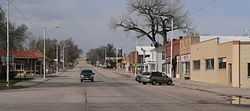Big Springs, Nebraska
| Big Springs, Nebraska | |
|---|---|
| Village | |
|
Downtown Big Springs, looking north up Pine Street | |
 Location of Big Springs, Nebraska | |
| Coordinates: 41°3′48″N 102°4′30″W / 41.06333°N 102.07500°WCoordinates: 41°3′48″N 102°4′30″W / 41.06333°N 102.07500°W | |
| Country | United States |
| State | Nebraska |
| County | Deuel |
| Area[1] | |
| • Total | 0.44 sq mi (1.14 km2) |
| • Land | 0.44 sq mi (1.14 km2) |
| • Water | 0 sq mi (0 km2) |
| Elevation | 3,373 ft (1,028 m) |
| Population (2010)[2] | |
| • Total | 400 |
| • Estimate (2012[3]) | 406 |
| • Density | 909.1/sq mi (351.0/km2) |
| Time zone | Mountain (MST) (UTC-7) |
| • Summer (DST) | MDT (UTC-6) |
| ZIP code | 69122 |
| Area code(s) | 308 |
| FIPS code | 31-04895[4] |
| GNIS feature ID | 0827434[5] |
Big Springs is a village in Deuel County, Nebraska, United States. The population was 400 at the 2010 census.
History
Big Springs was platted in 1884 when the railroad was extended to that point.[6] It was named from the stream that runs through town.[7] The Big Springs post office, established in 1884, was officially called Bigspring until 1943.[8] The village of Big Springs was incorporated in 1917.[9]
Geography
Big Springs is located at 41°3′48″N 102°4′30″W / 41.06333°N 102.07500°W (41.063399, -102.075111).[10]
According to the United States Census Bureau, the village has a total area of 0.44 square miles (1.14 km2), all of it land.[1]
Interstate 76 intersects Interstate 80 near the village.
Demographics
2010 census
As of the census[2] of 2010, there were 400 people, 186 households, and 119 families residing in the village. The population density was 909.1 inhabitants per square mile (351.0/km2). There were 217 housing units at an average density of 493.2 per square mile (190.4/km2). The racial makeup of the village was 94.5% White, 0.8% Native American, 2.5% from other races, and 2.3% from two or more races. Hispanic or Latino of any race were 8.0% of the population.
There were 186 households of which 19.9% had children under the age of 18 living with them, 53.8% were married couples living together, 5.9% had a female householder with no husband present, 4.3% had a male householder with no wife present, and 36.0% were non-families. 29.6% of all households were made up of individuals and 17.2% had someone living alone who was 65 years of age or older. The average household size was 2.15 and the average family size was 2.65.
The median age in the village was 50.1 years. 18.7% of residents were under the age of 18; 6% were between the ages of 18 and 24; 16.6% were from 25 to 44; 37.1% were from 45 to 64; and 22% were 65 years of age or older. The gender makeup of the village was 48.8% male and 51.3% female.
2000 census
As of the census[4] of 2000, there were 418 people, 187 households, and 124 families residing in the village. The population density was 1,135.0 people per square mile (436.2/km²). There were 216 housing units at an average density of 586.5 per square mile (225.4/km²). The racial makeup of the village was 95.93% White, 0.48% Native American, 3.35% from other races, and 0.24% from two or more races. Hispanic or Latino of any race were 5.26% of the population.
There were 187 households out of which 23.0% had children under the age of 18 living with them, 58.3% were married couples living together, 7.0% had a female householder with no husband present, and 33.2% were non-families. 31.0% of all households were made up of individuals and 16.6% had someone living alone who was 65 years of age or older. The average household size was 2.24 and the average family size was 2.79.
In the village the population was spread out with 20.8% under the age of 18, 5.7% from 18 to 24, 20.6% from 25 to 44, 25.4% from 45 to 64, and 27.5% who were 65 years of age or older. The median age was 46 years. For every 100 females there were 89.1 males. For every 100 females age 18 and over, there were 89.1 males.
As of 2000 the median income for a household in the village was $29,583, and the median income for a family was $39,375. Males had a median income of $25,536 versus $15,962 for females. The per capita income for the village was $16,319. About 5.4% of families and 8.2% of the population were below the poverty line, including 11.8% of those under age 18 and 7.6% of those age 65 or over.
References
- ↑ 1.0 1.1 "US Gazetteer files 2010". United States Census Bureau. Retrieved 2012-06-24.
- ↑ 2.0 2.1 "American FactFinder". United States Census Bureau. Retrieved 2012-06-24.
- ↑ "Population Estimates". United States Census Bureau. Retrieved 2013-05-29.
- ↑ 4.0 4.1 "American FactFinder". United States Census Bureau. Retrieved 2008-01-31.
- ↑ "US Board on Geographic Names". United States Geological Survey. 2007-10-25. Retrieved 2008-01-31.
- ↑ Shumway, Grant Lee (1921). History of Western Nebraska and Its People. Western publishing & engraving Company. p. 204.
- ↑ Fitzpatrick, Lillian L. (1960). Nebraska Place-Names. University of Nebraska Press. p. 52. A 1925 edition is available for download at University of Nebraska—Lincoln Digital Commons.
- ↑ "Deuel County". Jim Forte Postal History. Retrieved 25 August 2014.
- ↑ Shumway, Grant Lee (1921). History of Western Nebraska and Its People. Western publishing & engraving Company. p. 232.
- ↑ "US Gazetteer files: 2010, 2000, and 1990". United States Census Bureau. 2011-02-12. Retrieved 2011-04-23.
| |||||||||||||||||||||
